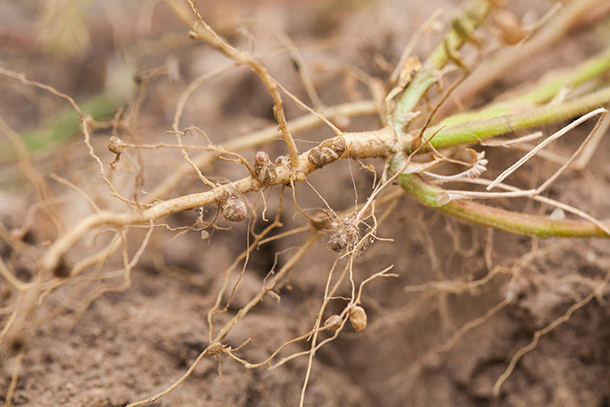Note on Emerging Science: Engineering a High-Yield Soybean
Air Date: Week of December 2, 2016

Root nodules in a legume plant containing nitrogen-fixing rhizobia. (Photo: Terraprima, Wikimedia Commons CC BY-SA 3.0)
Legumes are an important part of a balanced diet for billions of people around the world. A new and improved soybean plant may hold the key to greater food production without chemical fertilizers. Living on Earth’s Alexander Metzger discusses the botanical breakthrough in this week’s Note on Emerging Science.
Transcript
CURWOOD: It’s Living on Earth, I’m Steve Curwood. In a moment, the blobs that are taking over the oceans. But first, here’s this week’s Note on Emerging Science from Alex Metzger.
[SCIENCE NOTE THEME]
METZGER: Legumes -- foods like beans, peas and lentils - are among the oldest cultivated plants on earth. Their historical roots date back 5,000 years to Mesopotamia, the birthplace of agriculture. These crops are packed with protein, fiber and other nutrients and currently account for 30 percent of the world’s agricultural production.
They also enrich the soil by converting nitrogen from the atmosphere into a form plants can use through a symbiotic relationship with root bacteria known as “rhizobia.” So many organic and conservation-minded farmers plant legumes instead of adding synthetic fertilizers to their fields.
This nitrogen-fixing ability is the basis of a recent scientific breakthrough. Researchers at Washington State University have doubled the growth of soybean plants. They genetically modified the plants to absorb nitrogen faster, and so triggered rhizobia in the roots to fix more nitrogen. This chain reaction created bigger, healthier plants that produced more seed. There was also evidence that these modified plants could be more efficient in drought conditions.
The researchers hope that this breakthrough could increase global food supply while cutting down on harmful synthetic fertilizers, and make for the best of both worlds: a better fed population and a healthier environment.
That’s this week’s note on emerging science: I’m Alexander Metzger.
CURWOOD: And by the way, in case you are wondering, those new soybeans were not modified to make them resistant to pesticides.
[SCIENCE NOTE THEME]
Links
Washington State University News: Soybean nitrogen breakthrough could help feed the world
Capital Press: WSU researchers working to build a better soybean
Living on Earth wants to hear from you!
Living on Earth
62 Calef Highway, Suite 212
Lee, NH 03861
Telephone: 617-287-4121
E-mail: comments@loe.org
Newsletter [Click here]
Donate to Living on Earth!
Living on Earth is an independent media program and relies entirely on contributions from listeners and institutions supporting public service. Please donate now to preserve an independent environmental voice.
NewsletterLiving on Earth offers a weekly delivery of the show's rundown to your mailbox. Sign up for our newsletter today!
 Sailors For The Sea: Be the change you want to sea.
Sailors For The Sea: Be the change you want to sea.
 The Grantham Foundation for the Protection of the Environment: Committed to protecting and improving the health of the global environment.
The Grantham Foundation for the Protection of the Environment: Committed to protecting and improving the health of the global environment.
 Contribute to Living on Earth and receive, as our gift to you, an archival print of one of Mark Seth Lender's extraordinary wildlife photographs. Follow the link to see Mark's current collection of photographs.
Contribute to Living on Earth and receive, as our gift to you, an archival print of one of Mark Seth Lender's extraordinary wildlife photographs. Follow the link to see Mark's current collection of photographs.
 Buy a signed copy of Mark Seth Lender's book Smeagull the Seagull & support Living on Earth
Buy a signed copy of Mark Seth Lender's book Smeagull the Seagull & support Living on Earth

